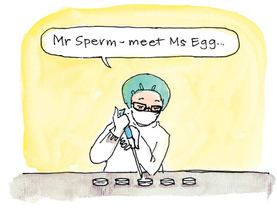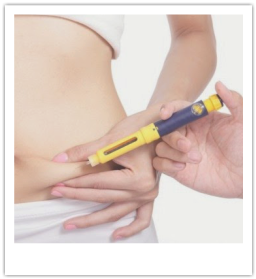|
Unlike IUI cycles, which take place over the course of one month using gonadotropins to stimulate the ovaries to produce one to three eggs, many IVF cycles take place over a two-month time span. Additional medications may precede ovarian stimulation with higher doses of gonadotropins for a longer period of time in order to obtain a greater number of eggs to be retrieved and exposed to sperm in the ART laboratory to create embryos for transfer to the uterus.
Each fertility center has its own protocols for IVF stimulation and physicians choose the protocol that they believe will optimize ovarian response for each patient based on her individual clinical situation. Patient age, diagnosis and previous response to stimulation are all considered. The following is a general description of a typical ART stimulation protocol. Your doctor or nurse will discuss your protocol with you and give you specific instructions regarding medication dose and schedule. IVF stimulation protocols start with your period. You will need to contact your physician or nurse on the first day of your period for specific instructions. These protocols are used for women doing IVF with their own eggs and for women who are Egg Donors. Birth Control Pills Many physicians will use the first month of the IVF cycle to quiet the ovaries in order to have control during the second month of stimulation. This may involve taking birth control pills starting cycle day 3 for 12 to 28 days. GnRH Agonists The GnRH agonist, leuprolide acetate or Lupron, is used to suppress the ability of the pituitary gland to release follicle stimulating hormone FSH and leutinizing hormone LH. This means that the ovaries will not be able to make an egg or ovulate without taking gonadotropins. This works well for IVF cycles so that gonadotropins can be given to recruit a good number of follicles containing eggs without the risk that a spontaneous LH surge would cause ovulation before egg retrieval. There are several ways to use leuprolide acetate/Lupron in IVF stimulation protocols. Your physician will choose the protocol that will optimize your response. Protocols include:
Once there are enough mature follicles and a high enough estradiol level, both leuprolide acetate/Lupron and gonadotropins are discontinued and a single injection of HCG is taken on a particular day at a specific time that is determined by the scheduled egg retrieval day and time. HCG injections are generally given 32 to 34 hours before scheduled egg retrieval.
Most women take gonadotropins for 3 to 5 days and then have an ultrasound and blood test to evaluate their response. At this point the dosage may stay the same, increase or decrease and another ultrasound and blood test will be scheduled within 1 to 3 days. Stimulation often takes 10 to 13 days. This process continues until there are enough follicles of a good size and a high enough estradiol level to proceed to egg retrieval. At that time all stimulation protocol medications are discontinued and a single injection of an HCG product (Ovidrel, Novarel, Pregnyl, generic HCG) is given 32 to 34 hours prior to egg retrieval. This injection causes the eggs to mature and be retrieved from the ovaries. Intended Mothers or Egg Donors should not require any medications after egg retrieval. Progesterone Most physicians will prescribe a Progesterone product starting the day of or day after egg retrieval each evening until the pregnancy test. Progesterone may be given orally, vaginally or as an IM injection. Progesterone stimulates the uterine lining (endometrium) to continue to develop so that an embryo that implants will have a thick, supportive environment to nourish it. Please remember that your clinic may require a different medical protocol for your unique situation and this information is not to take the place of your own physician’s orders. Second Chance Surrogacy does not have the medical knowledge to advise or diagnose medical treatments or medications.
0 Comments
 “常春藤名校毕业、成绩全优、蓝眼睛、金发、年轻、美丽、身材高挑......” 许多人在挑选卵子捐助者时,都希望可以挑选到理想的完美捐卵人。 通常,不同的捐卵公司都会有自己的一些捐卵者筛选标准,比如:性传播疾病筛查、心理评估、生育能力评估以及基因筛查等。其中,基因筛查主要包括:携带者筛查(连锁隐性遗传病评估)和家族病史(常染色体显性遗传病评估) 常见的捐卵人家族病史包括:
家族病史评估中可能存在一些问题,比如,捐卵人是被领养,捐卵人对家族信息所知有限(像多年离散或不见的父亲),捐卵人没有给出准备信息等等。 因此,在你被心目中的 ”完美捐卵人” 的外在因素倾倒之前,我的建议是:
 时至今日,但凡你对试管婴儿(IVF)做过一点调查研究,就会了解到试管婴儿治疗在美国已经是一个颇具规模的产业了。 对于没有太多经验的患者来说,怎样识别“好的”和“差的”试管婴儿中心/诊所,其实是很难的,因为他们看起来都差不多,而普通患者根本没有能力和精力来比较和鉴别。 比如,许多诊所会在广告上写出他们目前使用的是“最新设备,以及第**代筛选技术”。但是,这些往往都是营销噱头来获得媒体宣传使用的,并不能真正帮助病人或提高成功率。这些“高科技噱头”在经过一轮冲洗检验后终归会恢复平静,变为尘埃。 不幸的是,这里并没有一个简单的答案。仅仅通过一个诊所的规模大小并没什么帮助(一些大的旗舰式诊所只是赚钱工厂而已),SART(辅助生殖技术协会)的成功率报告如果被解读不当,也会让你走入歧途。 我觉得有效的解决办法就是首先您要充分了解什么是试管婴儿(IVF)治疗,以及整个治疗都涉及哪些部分,以便于您清楚自己选择的诊所是否能提供(目前可得的)最先进技术。比如说,他们是否提供玻璃化冷冻技术(Vitrification)?是否提供胚胎影像文件?是否提供PGD/PGS 筛查?当然,如果可以请一个业内的专业咨询人士做顾问,是会省掉您不少的时间和精力。 以下一些危险信号,是您选择诊所时需要注意的:
后两条是目前广告效应比较大(或知名度非常高)的诊所存在的普遍问题。试管婴儿治疗中,医生对病人整个治疗周期的亲自监测及跟踪是治疗中的重要环节,如果医生因为超负荷接待病人而没时间做他们本应提供的服务或无法及时回答病人的问题,那您在选择医生时,需多加考量。 此外,虽然说试管婴儿(IVF)治疗的结果有很多不确定性,因为医生并不能控制胚胎的着床情况,但是好的试管婴儿诊所是可以培养良好质量的胚胎的,因为这与实验室及胚胎学专家的技术水平有着直接联系。好的诊所对他们的技术感到自豪,所以很愿意向病人展示胚胎影像。 当然也有一些规模不大但注重个人化服务的试管婴儿诊所,这也是SCS代孕咨询所注重的精品式服务方式,因为辅助生殖领域的服务是无法大量和流水线作业的。但无论如何,一个好的诊所的服务都是透明、专业和娴熟的。作为患者,要做好充分的调研及自我教育,然后决定什么才是最适合你的。 |
Second Chance Surrogacy
第三方辅助生殖领域信息及知识普及。为您在面临重要选择时,提供咨询及帮助。 归档
July 2017
文章分类
|
Second chance Surrogacy
|
info@secondchancesurrogacy.com
|
|


 RSS Feed
RSS Feed